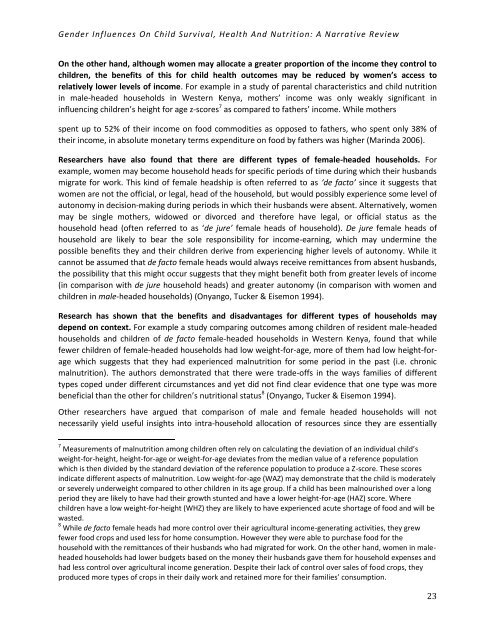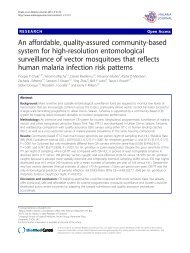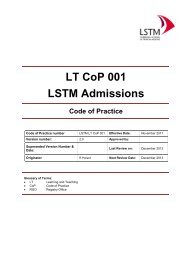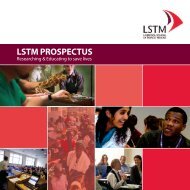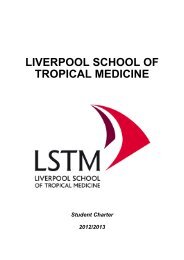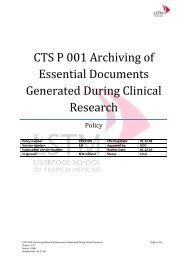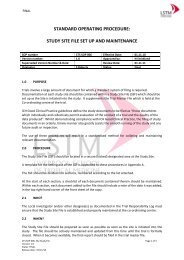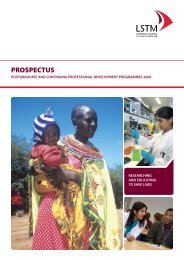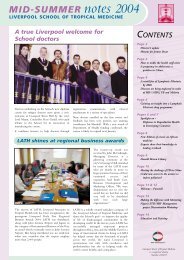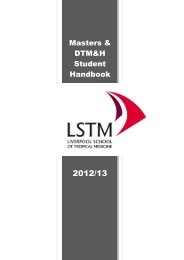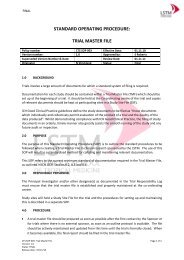Gender influences on child survival, health and nutrition: a ... - Unicef
Gender influences on child survival, health and nutrition: a ... - Unicef
Gender influences on child survival, health and nutrition: a ... - Unicef
You also want an ePaper? Increase the reach of your titles
YUMPU automatically turns print PDFs into web optimized ePapers that Google loves.
<str<strong>on</strong>g>Gender</str<strong>on</strong>g> Influences On Child Survival, Health And Nutriti<strong>on</strong>: A Narrative Review<br />
On the other h<strong>and</strong>, although women may allocate a greater proporti<strong>on</strong> of the income they c<strong>on</strong>trol to<br />
<strong>child</strong>ren, the benefits of this for <strong>child</strong> <strong>health</strong> outcomes may be reduced by women’s access to<br />
relatively lower levels of income. For example in a study of parental characteristics <strong>and</strong> <strong>child</strong> nutriti<strong>on</strong><br />
in male-headed households in Western Kenya, mothers’ income was <strong>on</strong>ly weakly significant in<br />
influencing <strong>child</strong>ren’s height for age z-scores 7 as compared to fathers’ income. While mothers<br />
spent up to 52% of their income <strong>on</strong> food commodities as opposed to fathers, who spent <strong>on</strong>ly 38% of<br />
their income, in absolute m<strong>on</strong>etary terms expenditure <strong>on</strong> food by fathers was higher (Marinda 2006).<br />
Researchers have also found that there are different types of female-headed households. For<br />
example, women may become household heads for specific periods of time during which their husb<strong>and</strong>s<br />
migrate for work. This kind of female headship is often referred to as ‘de facto’ since it suggests that<br />
women are not the official, or legal, head of the household, but would possibly experience some level of<br />
aut<strong>on</strong>omy in decisi<strong>on</strong>-making during periods in which their husb<strong>and</strong>s were absent. Alternatively, women<br />
may be single mothers, widowed or divorced <strong>and</strong> therefore have legal, or official status as the<br />
household head (often referred to as ‘de jure’ female heads of household). De jure female heads of<br />
household are likely to bear the sole resp<strong>on</strong>sibility for income-earning, which may undermine the<br />
possible benefits they <strong>and</strong> their <strong>child</strong>ren derive from experiencing higher levels of aut<strong>on</strong>omy. While it<br />
cannot be assumed that de facto female heads would always receive remittances from absent husb<strong>and</strong>s,<br />
the possibility that this might occur suggests that they might benefit both from greater levels of income<br />
(in comparis<strong>on</strong> with de jure household heads) <strong>and</strong> greater aut<strong>on</strong>omy (in comparis<strong>on</strong> with women <strong>and</strong><br />
<strong>child</strong>ren in male-headed households) (Onyango, Tucker & Eisem<strong>on</strong> 1994).<br />
Research has shown that the benefits <strong>and</strong> disadvantages for different types of households may<br />
depend <strong>on</strong> c<strong>on</strong>text. For example a study comparing outcomes am<strong>on</strong>g <strong>child</strong>ren of resident male-headed<br />
households <strong>and</strong> <strong>child</strong>ren of de facto female-headed households in Western Kenya, found that while<br />
fewer <strong>child</strong>ren of female-headed households had low weight-for-age, more of them had low height-forage<br />
which suggests that they had experienced malnutriti<strong>on</strong> for some period in the past (i.e. chr<strong>on</strong>ic<br />
malnutriti<strong>on</strong>). The authors dem<strong>on</strong>strated that there were trade-offs in the ways families of different<br />
types coped under different circumstances <strong>and</strong> yet did not find clear evidence that <strong>on</strong>e type was more<br />
beneficial than the other for <strong>child</strong>ren’s nutriti<strong>on</strong>al status 8 (Onyango, Tucker & Eisem<strong>on</strong> 1994).<br />
Other researchers have argued that comparis<strong>on</strong> of male <strong>and</strong> female headed households will not<br />
necessarily yield useful insights into intra-household allocati<strong>on</strong> of resources since they are essentially<br />
7 Measurements of malnutriti<strong>on</strong> am<strong>on</strong>g <strong>child</strong>ren often rely <strong>on</strong> calculating the deviati<strong>on</strong> of an individual <strong>child</strong>’s<br />
weight-for-height, height-for-age or weight-for-age deviates from the median value of a reference populati<strong>on</strong><br />
which is then divided by the st<strong>and</strong>ard deviati<strong>on</strong> of the reference populati<strong>on</strong> to produce a Z-score. These scores<br />
indicate different aspects of malnutriti<strong>on</strong>. Low weight-for-age (WAZ) may dem<strong>on</strong>strate that the <strong>child</strong> is moderately<br />
or severely underweight compared to other <strong>child</strong>ren in its age group. If a <strong>child</strong> has been malnourished over a l<strong>on</strong>g<br />
period they are likely to have had their growth stunted <strong>and</strong> have a lower height-for-age (HAZ) score. Where<br />
<strong>child</strong>ren have a low weight-for-height (WHZ) they are likely to have experienced acute shortage of food <strong>and</strong> will be<br />
wasted.<br />
8 While de facto female heads had more c<strong>on</strong>trol over their agricultural income-generating activities, they grew<br />
fewer food crops <strong>and</strong> used less for home c<strong>on</strong>sumpti<strong>on</strong>. However they were able to purchase food for the<br />
household with the remittances of their husb<strong>and</strong>s who had migrated for work. On the other h<strong>and</strong>, women in maleheaded<br />
households had lower budgets based <strong>on</strong> the m<strong>on</strong>ey their husb<strong>and</strong>s gave them for household expenses <strong>and</strong><br />
had less c<strong>on</strong>trol over agricultural income generati<strong>on</strong>. Despite their lack of c<strong>on</strong>trol over sales of food crops, they<br />
produced more types of crops in their daily work <strong>and</strong> retained more for their families’ c<strong>on</strong>sumpti<strong>on</strong>.<br />
23


